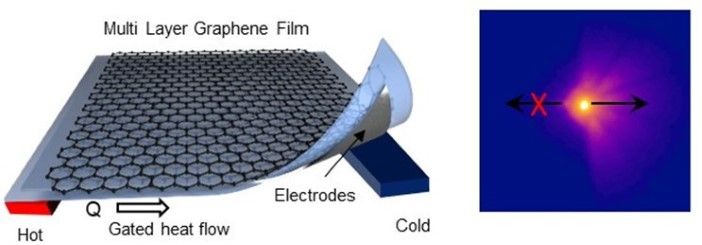Researchers from the University of Manchester have successfully tested a device capable of electrically controlling heat flow suitable for use in thermal management applications in aircraft and spacecraft.
The international team, which was led by researchers from the University of Manchester’s National Graphene Institute (NGI), used high thermal conductivity graphite films to make the switch.
When a voltage is applied, ions insert between the graphite layers. These ions disrupt phonon motion, cutting thermal conductivity by up to 1,300%.
Removing the voltage expels the ions and restores the original heat-carrying capacity. This powerful modulation allows the device to actively turn heat conduction “on” and “off” at will, mirroring the functionality of electronic transistors, but for heat instead of electricity.
“What makes our device truly transformative is its ability to operate reliably in extreme environments such as space,” said Dr Pietro Steiner, lead author and current technology lead for graphene-based thermal technologies at SmartIR, a spinout from the University of Manchester. “The solid-state nature and absence of mechanical parts make it particularly attractive for aerospace applications, where reliability, weight, and efficiency are critical.”
Beyond basic switching, the team demonstrated that their device could actively steer heat flow in desired directions. By configuring voltages across patterned electrodes, they created anisotropic thermal conduction pathways, opening possibilities for programmable thermal management systems.
Lead author of the study Professor Coskun Kocabas added, “This thermal switching technology could revolutionise spacecraft thermal regulation, offering dynamic and reconfigurable solutions to manage excess heat without complex moving mechanisms or bulky radiators.”
Spacecraft often rely on radiators or mechanical valves to dump excess heat. These systems add weight and risk mechanical failure under vibration. A thin, solid-state switch removes those constraints. It can operate in ultra-high vacuum and tolerate radiation levels found in orbit.
Next, the group will test switching speed under high thermal load. They plan to integrate the switch with prototype electronics. Faster ion motion and alternative intercalants could boost performance further. By directly linking electrical signals to heat transport, this work lays the groundwork for programmable thermal management in aerospace, electronics cooling and adaptive insulation.
The results of the study “Electrically controlled heat transport in graphite films via reversible ionic liquid intercalation” have been published in the journal Science Advances.
